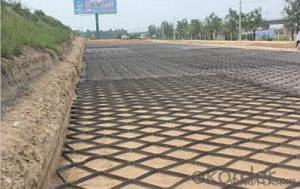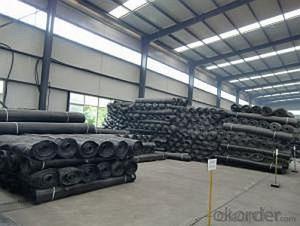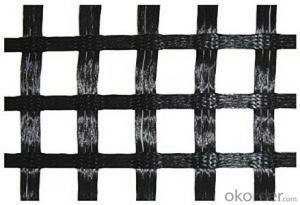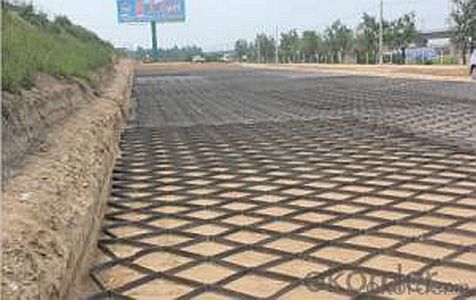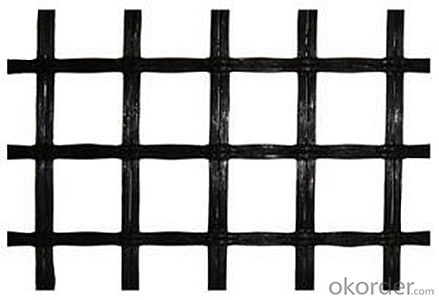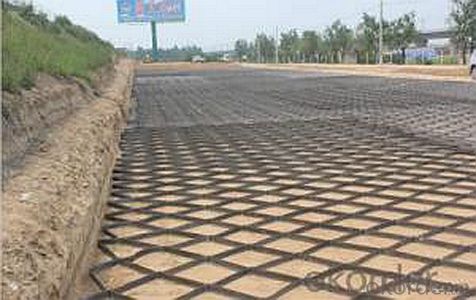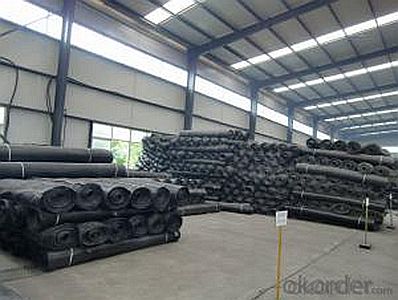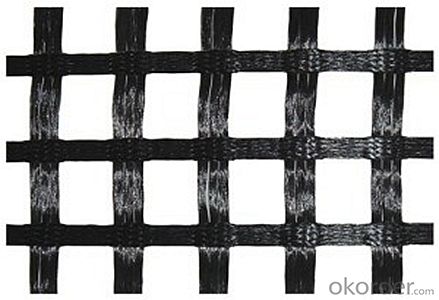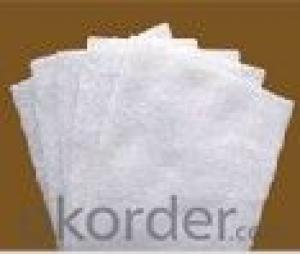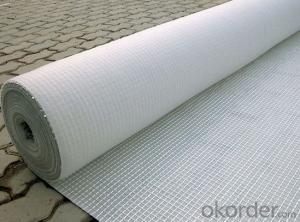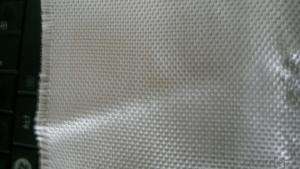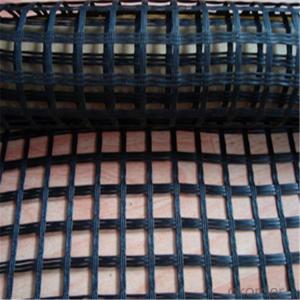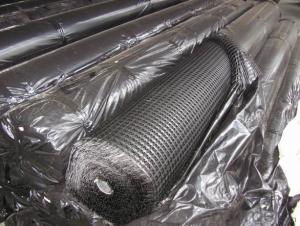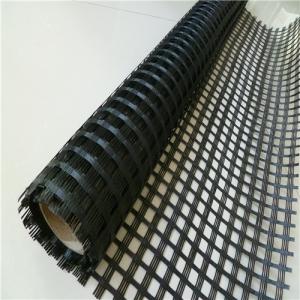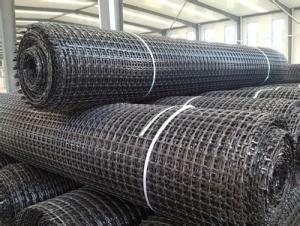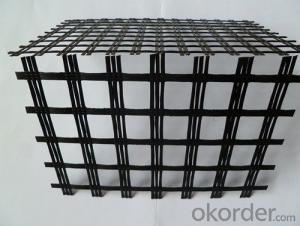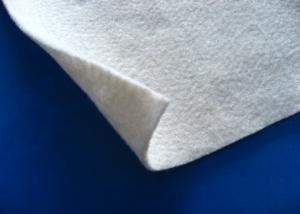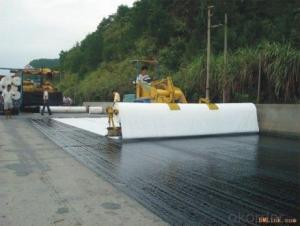Woven Monofilament High Tensile Strength Fiberglass Geogrid
- Loading Port:
- China main port
- Payment Terms:
- TT OR LC
- Min Order Qty:
- 1000 m²
- Supply Capability:
- 1000000 m²/month
OKorder Service Pledge
OKorder Financial Service
You Might Also Like
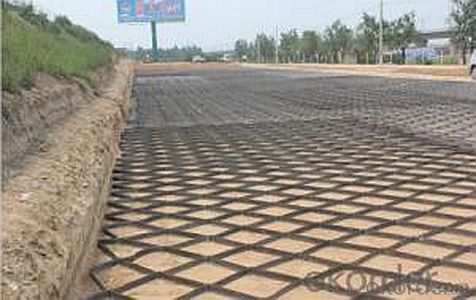
Fiberglass Geogrid Application
1. Road surface asphalt overlay construction engineering; Asphalt layers
reinforcement.
2. Converting old cement concrete road into composite road; Restraining
reflection cracking caused by block shrinkage.
3. Road extension; Preventing and controlling the cracking caused by new
and old combination and uneven settlement.
4. Treatment of the conjunction between tunnel and bridge or foundation.
Fiberglass Geogrid Introduction
Fiberglass geogrid is a kind of planar mesh material using alkali-free fiberglass yarn as
base body and then coated with high quality modified asphalt. It is warp knitted with
oriental structure which gives full play of yarn strength and improves its mechanical
property to make the product high tensile, tearing and creep-resistant. Moreover, the
composite property of coating with asphalt makes full protection of the fiberglass matrix
and greatly improves its wear and shear resistance. All the advantageous functions make
the product have a good performance in pavement strengthening, track cracking and solving
difficulties of strengthening the bituminous pavement.
Our Service
Quality assurance
1.On a regular basis or as per your request,we entrust national testing agencies to conduct quality inspections
2. Strictly in accordance with the ISO9001-2008 international quality system standard,we monitor and manage the whole process throughout production,quality testing,and measurement to ensure product quality
3. For quality-related construction delay or substandard construction(except for damage or losses due to customer’s responsibility or irresistible natural disasters),we have refunding,replacement,and repair services.We will respond to customers’ feedbacks on quality issues within 24 hours.
Packaging & Shipping
Packing: PLASTIC FILM INSIDE, AND WOVEN BAG OUTSIDE
Shipping: About 15 days after receipt the deposit
FAQ:
Q: What kind of payments does jenor support?
A: T/T, L/C, Cash are accepted.
Q: Do you charge for the samples?
A: Accordeing to our company policy, the samples are free, we only charge the freight fee. And we will return the freight fee during the next order.
Q: Can you produce according to customers' design?
A: Sure, we are professional manufacturer, OEM and ODM are both welcome.
Q: Do you have other products?
A: Yes, please check the pictures:
- Q: The vertical permeability coefficient of 400 g per square filament geotextile is generally how much
- 1.0 × 10-1cm / sK × (10-1-10-3) I specialize in the production of geotechnical materials
- Q: Are geotextiles suitable for use in gabion walls?
- Yes, geotextiles are suitable for use in gabion walls. Geotextiles help to improve the stability and durability of gabion walls by providing reinforcement and separation between the backfill materials and the stones within the gabion baskets. They also aid in preventing soil erosion, promoting proper drainage, and enhancing overall performance of the gabion structure.
- Q: How do geotextiles help with soil separation?
- Geotextiles help with soil separation by creating a barrier between different soil layers, preventing mixing and maintaining their distinct characteristics.
- Q: Can geotextiles be used for drainage?
- Yes, geotextiles can be used for drainage. They are commonly used in various drainage applications such as road construction, retaining walls, and landfills. Geotextiles help in preventing soil erosion, filtering out sediments, and allowing water to pass through while retaining the soil.
- Q: Fish pond geotextile use method
- Not geotextile to use impermeable geotextile is a filtering effect
- Q: What are the different manufacturing methods for geotextiles?
- There are several different manufacturing methods for geotextiles, including weaving, knitting, and nonwoven processes. Weaving involves interlacing two sets of yarns, warp, and weft, to create a fabric with an ordered structure. Knitting, on the other hand, uses a series of interconnected loops to form a fabric. Nonwoven processes involve bonding fibers together through methods such as needle punching, thermal bonding, or chemical bonding. Each method has its own advantages and is used depending on the specific requirements of the geotextile application.
- Q: Geotextile how the weight of how many meters
- Cut with a pair of scissors 1 square meters, and then weighed, the total weight ÷ weight per square meter ÷ geotextile width = length meter (because the weight of geotextile deviation, the calculation results can only be roughly the same, not subject)
- Q: What are the key factors affecting the UV stability of geotextiles?
- The key factors affecting the UV stability of geotextiles include the type of polymer used in the geotextile, the thickness of the material, the presence of additives or stabilizers, the exposure duration and intensity of UV radiation, and the environmental conditions in which the geotextile is deployed.
- Q: How do geotextiles help with load transfer in foundation systems?
- Geotextiles improve load transfer in foundation systems by distributing the load from the structure to a wider area, reducing the stress on the underlying soil and preventing soil settlement. They also help to reinforce weak or unstable soils, enhancing their load-bearing capacity and stability.
- Q: How do geotextiles improve the performance of embankments?
- Geotextiles improve the performance of embankments by providing reinforcement and stability to the soil structure. They act as a barrier against soil erosion, preventing the loss of soil particles and maintaining the integrity of the embankment. Geotextiles also allow water to pass through while retaining the soil, enhancing drainage and preventing water buildup that could weaken the embankment. Additionally, geotextiles distribute the load more evenly, reducing the potential for settling and improving overall stability of the embankment.
Send your message to us
Woven Monofilament High Tensile Strength Fiberglass Geogrid
- Loading Port:
- China main port
- Payment Terms:
- TT OR LC
- Min Order Qty:
- 1000 m²
- Supply Capability:
- 1000000 m²/month
OKorder Service Pledge
OKorder Financial Service
Similar products
Hot products
Hot Searches
Related keywords
